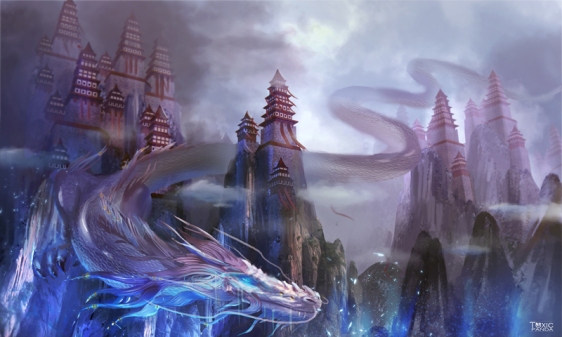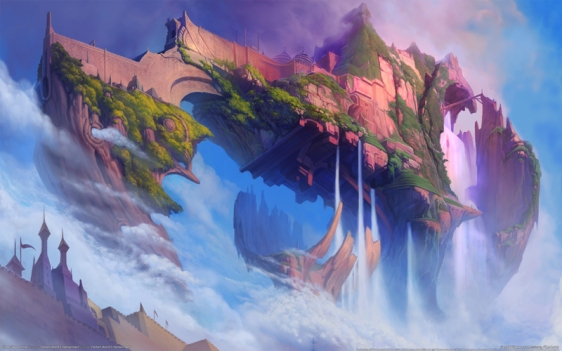Whilst many Fantasy Artists, can choose to play with their perspectives – there are those that prefer to “keep it simple”, and bring magic to their artwork, through other paths. Here do we encounter, one such Fantasy Realm, that achieves a magical effect – through it’s stunning use of contrast:

Fantasy Castle – Fantasy Shields
I feel that this artist has chosen to play with their contrast, in two specific areas. First: the choice of a simple two point perspective (that is barely detectable); which in-turn, is contrasted with the “overpowering scale” of the Castle’s Sphere (which is anything but ignorable). The simple two point perspective, is only really visible, on the Castle’s outermost Walls/Towers (to the left and right). This idea of simplicity, is repeated on the background – as the “rolling hills” feature little to no clouds. On the other hand, do we find that the Sphere’s scale is gigantic! So gigantic (and complex) in fact, that it dominates the artwork 🙂 In doing so, does the Sphere play right into – the “relative unimportance” of the constructs at it’s feet. It is here that I feel the artist, has left interpretation open to the viewer. As it seems to me, that the constructs at this Sphere’s feet, could be one of three things: i) An encamped Army (hinted at by the warriors/men on the fore-hill). ii) Simply the smaller buildings (and lives) of a surrounding Village and it’s people. iii) That of a Castle, and it’s town, both under siege (which would be both i and ii). It’s hard to say for sure, as it seems that the constructs in this area, have been left deliberately vague and unclear. Second: the choice of lighting, between Sphere and Background/Foreground. The Sphere is so large and bright, that it is akin to a Sun. Whilst the Dark, is so expansive and silhouette, that it is akin to an Interstellar. The Sphere is so central and remote, that is is akin to a Quasar. Whilst the Dark, is so enveloping and shear, that it is akin to both Space and Time. Why has the artist done this? I suspect in an attempt, to explain the difference between Light and Dark 🙂 The Light is both Golden and Kingly, with a twist of the Eternal. The Dark is both Mysterious and Quite, with a twist of the Rebel. And yet, here do I find a third meaning – that Light cannot exist without the Dark. For it seems that this Castle’s Sphere, also contains something of the Cosmos itself! Finally: Something of an “unusual” Fantasy piece, that hints at several things – yet answers none. Consider. Is this Castle a part of the Land, or has it come from Outer Space? Is this Castle’s interior on the same scale as the surrounding Men, or does something bigger reside there? Is this Castle akin to a God? As far beyond the surrounding Men, as the reach of the Cosmos itself? Who knows – not me! Its a great workout for your imagination though 🙂







